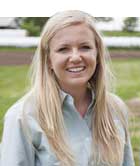Boost returns from grazed sorghums |
| By Sydney Sleep, Editorial Intern |
|
|
 Summer annual forages supplement permanent pastures by providing high-quality forage and complementing summer perennial grasses. “Due to the higher input cost of establishing summer annual forages such as forage sorghums, sudangrass, sorghum-sudangrass hybrids, and millets, they need to be managed and grazed more efficiently,” says Rocky Lemus, Mississippi State University extension forage specialist. He asserts that producers finishing cattle on pasture or running stockers looking to generate a blacker bottom line can benefit from growing summer annuals. Maximum returns begin with the proper seeding rate, depth, and planting date. “It is important not to plant the whole area all at once because summer annuals have rapid growth potential in hot summer conditions,” explains Lemus. In his June Forage News, Lemus recommends subdividing the pasture into two to three sections and staggering planting at least one to two weeks apart. This reduces the possibility of the entire forage crop maturing at the same time, which can result in a loss of forage quality. “Utilizing a strip grazing system and allocating areas that can be moved every three to five days can improve grazing efficiency and stretch the forage supply. There is opportunity for a significant drop in efficiency if the summer annuals are allowed to grow taller than the cattle grazing them,” notes Lemus. A strip grazing system demonstration was conducted last year at Mississippi State. Green Grazer V sorghum-sudangrass hybrid was planted in 4 acres at 25 pounds per acre following annual ryegrass. The crop was fertilized with 50 pounds of nitrogen per acre after emergence. Ten steers averaging 560 pounds were then grazed for 56 days using a strip grazing system. The cattle had an average daily gain of 1.23 pounds per head with a total gain of 172 pounds per acre. Start grazing sorghum and sorghum-sudangrass hybrids when they are between 18 and 36 inches tall because they can accumulate high levels of prussic acid and nitrates. Nitrate accumulation usually occurs in the lower 6 inches of the plant. “Low levels of nitrates and prussic acid are always present in sorghum and sorghum-sudangrass hybrids, but factors that cause stress such as drought, frost, disease, and herbicide injury can lead to toxicity,” says Lemus. He adds that pearl millet does not contain prussic acid so it can be safely grazed at any stage of growth. Lemus notes that when selecting a summer annual forage variety for your area, it is beneficial to compare the performance of available varieties against each other. In most cases, there can be year-to-year variability among summer annual species ranging from 10 to 40 percent. Several universities provide performance data for summer annual varieties. Fertilizer applications for summer annuals need to follow soil test recommendations for lime, phosphorus, and potassium. Apply nitrogen after emergence when the plants are 2 to 3 inches tall. For more information about growing summer annuals, see last week’s Forage Flash, Bolster summer forage with annuals.  Sydney Sleep Sydney Sleep grew up on her family’s Angus operation outside of Spearfish, S.D. She is currently attending South Dakota State University where she is pursuing a degree in agriculture communications. At college, Sleep is an ambassador for the SDSU College of Agriculture and Biological Sciences, is a member of Sigma Alpha professional agricultural sorority, and works as the communications assistant for the College of Agriculture and Biological Sciences. She is serving as the 2016 Hay & Forage Grower summer editorial intern. |
